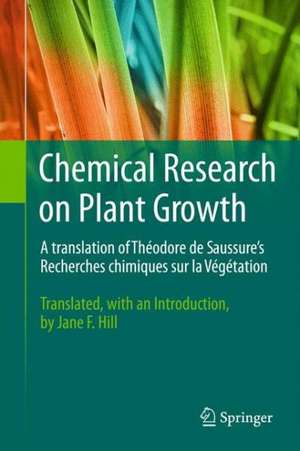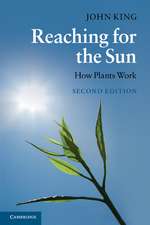Chemical Research on Plant Growth: A translation of Théodore de Saussure's Recherches chimiques sur la Végétation by Jane F. Hill
Traducere de Jane F. Hill Autor Théodore de Saussureen Limba Engleză Hardback – 8 mar 2013
A further note about the translation: This project is more than just a translation because it includes an extensive introduction as well as notes that provide explanations for archaic terminology and other background material.
In the twentieth century, eminent photosynthesis researcher Eugene Rabinowitch described Recherches Chimiques sur la Végétation as the first modern book on plant nutrition. Historian of chemistry Henry Leicester called the book a classic, noting that the first important generalization about biochemistry in the nineteenth century came from it. Plant physiologist P. E. Pilet stated that the book laid the foundations of a new science, phytochemistry. Soil scientist E. Walter Russell attributed to de Saussure the quantitative experimental method, which more than anything else made modern agricultural chemistry possible. Chemist Leonard K. Nash stated that de Saussure brought the studies of plant nutrition begun by Priestley, Ingen-Housz, and Senebier close to completion, finishing the basic experimental work and providing a convincing theoretical interpretation of the field, and also opened up new vistas of experiment and thought.
In the two centuries since Recherches Chimiques sur la Végétation was published, luminaries in various branches of science, including plant biology, chemistry, and soil science, have consistently praised it highly. In the nineteenth century, noted botanist Alphonse de Candolle and equally noted plant physiologist Julius von Sachs expressed great admiration for it. Although de Saussure’s ideas were forgotten for a time, famed chemist Justus von Liebig, who invented artificial fertilizer, rediscovered them in the 1840s and brought them to the attention of the agricultural community, stressing their importance for increasing crop yields.
| Toate formatele și edițiile | Preț | Express |
|---|---|---|
| Paperback (1) | 942.44 lei 6-8 săpt. | |
| Springer – 2 apr 2015 | 942.44 lei 6-8 săpt. | |
| Hardback (1) | 948.47 lei 6-8 săpt. | |
| Springer – 8 mar 2013 | 948.47 lei 6-8 săpt. |
Preț: 948.47 lei
Preț vechi: 1156.67 lei
-18% Nou
Puncte Express: 1423
Preț estimativ în valută:
181.49€ • 187.24$ • 151.45£
181.49€ • 187.24$ • 151.45£
Carte tipărită la comandă
Livrare economică 27 martie-10 aprilie
Preluare comenzi: 021 569.72.76
Specificații
ISBN-13: 9781461441359
ISBN-10: 1461441358
Pagini: 254
Ilustrații: LIX, 192 p.
Dimensiuni: 155 x 235 x 20 mm
Greutate: 0.53 kg
Ediția:2013
Editura: Springer
Colecția Springer
Locul publicării:New York, NY, United States
ISBN-10: 1461441358
Pagini: 254
Ilustrații: LIX, 192 p.
Dimensiuni: 155 x 235 x 20 mm
Greutate: 0.53 kg
Ediția:2013
Editura: Springer
Colecția Springer
Locul publicării:New York, NY, United States
Public țintă
ResearchCuprins
Foreword.- Acknowledgments.- About the Translator.- Brief Biography of Théodore de Saussure.- 1.Introduction.- A. Plant nutrition concepts before the pioneering research on photosynthesis.- B. Contributions to knowledge of plant nutrition and physiology by the photosynthesis pioneers who preceded Théodore de Saussure.- C. De Saussure provides extensive quantitative data to address the important questions.- D. De Saussure’s work enables completion of the overall chemical equation for photosynthesis.- E. Critical reception of Recherches chimiques sur la Végétation, its legacy, and historical perspectives.- F. Some errors and misinterpretations in Recherches chimiques sur la Végétation.- G.The life and scientific background of Théodore de Saussure.- References Cited.- 2.Chapter Summaries.- A Note on the Translation.- Translation of Recherches chimiques sur la Végétation.- Preface by Théodore de Saussure.- Table of Contents of the text.- The Text.- Appendices.- 1. Glossary of Terms.- 2. Conversions of Units of Measurement.- 3. Expanded Bibliography of References Cited by de Saussure.- Index
Recenzii
Notă biografică
Nicholas-Théodore de Saussure, a Swiss plant physiologist and plant chemist, was the last of the early pioneers of photosynthesis research. This initial period of research is generally considered to have begun with Jan van Helmont in the early seventeenth century and Stephen Hales in the first part of the eighteenth, then to have become more intense with Joseph Priestley, Jan Ingen-Housz, and Jean Senebier during the Scientific Revolution of the mid-to-late eighteenth century. Nicholas-Théodore’s father, the famous Swiss geologist, meteorologist, and Alpine explorer Horace-Bénédict de Saussure, had been an early convert to the new chemical theories pioneered by Antoine Lavoisier in the late eighteenth century. Nicholas-Théodore, younger than his predecessors, had the full advantage of this new approach, which stressed quantitative chemical methods. Applying these methods to plants, Nicholas-Théodore de Saussure performed experiments that led him to major insights into plant nutrition. His most important contributions were the demonstration that water is a component of plant dry matter; that plants obtain their carbon from the carbon dioxide of the air, not from carbonic acid dissolved in the soil water, as most of his contemporaries believed; and that mineral elements and nitrogen from the soil are essential to plant growth. Further, he demonstrated the central fact of plant respiration (the absorption of oxygen and emission of carbon dioxide); and photosynthesis (the decomposition of carbon dioxide and evolution of oxygen in the light). In Recherches Chimiques sur la Végétation, de Saussure synthesized his own research findings with those of his predecessors, producing a pioneering work on plant nutrition.
Translator: Jane F. Hill received an undergraduate degree in English from Carleton College, Northfield, Minnesota, USA, in 1968, and earned a master’s degree in biology and a doctorate in botany from The George Washington University, Washington, D.C., USA, in 1976 and 1980, respectively. Before entering graduate school, she worked as a writer and editor for the United States Department of Agriculture (USDA) Soil Conservation Service, where she developed an interest in plant growth, agronomy, and soil science. As a graduate student, she worked in dendroclimatology research at the U.S.Department of the Interior, U.S. Geological Survery, Reston, Va., and later was a volunteer collaborator at plant research laboratories at the USDA Beltsville Agricultural Research Center, Beltsville, MD, USA. She has written extensively on a variety of subjects involving many aspects of botany and biology, including encyclopedia essays on pioneering photosynthesis research and other 18th and 19th century history-of-science topics. She wrote a chapter on the early photosynthesis pioneers for Volume 34 in the series Advances in Photosynthesis and Respiration (J.J. Eaton-Rye, B.C.Tripathy, and T.D. Sharkey, eds.; Govindjee and Sharkey, series eds., 2012, Springer).
In addition, Dr. Hill has co-authored a 500-page book on structure, function, and development of woody plants (J.A. Romberger, Z. Hejnowicz, and J.F. Hill 1993, Springer-Verlag; re-issued 2004, Blackburn Press). Also, she has published original research papers on dendroclimatology and wood structure in the American Journal of Botany.
Translator: Jane F. Hill received an undergraduate degree in English from Carleton College, Northfield, Minnesota, USA, in 1968, and earned a master’s degree in biology and a doctorate in botany from The George Washington University, Washington, D.C., USA, in 1976 and 1980, respectively. Before entering graduate school, she worked as a writer and editor for the United States Department of Agriculture (USDA) Soil Conservation Service, where she developed an interest in plant growth, agronomy, and soil science. As a graduate student, she worked in dendroclimatology research at the U.S.Department of the Interior, U.S. Geological Survery, Reston, Va., and later was a volunteer collaborator at plant research laboratories at the USDA Beltsville Agricultural Research Center, Beltsville, MD, USA. She has written extensively on a variety of subjects involving many aspects of botany and biology, including encyclopedia essays on pioneering photosynthesis research and other 18th and 19th century history-of-science topics. She wrote a chapter on the early photosynthesis pioneers for Volume 34 in the series Advances in Photosynthesis and Respiration (J.J. Eaton-Rye, B.C.Tripathy, and T.D. Sharkey, eds.; Govindjee and Sharkey, series eds., 2012, Springer).
In addition, Dr. Hill has co-authored a 500-page book on structure, function, and development of woody plants (J.A. Romberger, Z. Hejnowicz, and J.F. Hill 1993, Springer-Verlag; re-issued 2004, Blackburn Press). Also, she has published original research papers on dendroclimatology and wood structure in the American Journal of Botany.
Textul de pe ultima copertă
Nicholas-Théodore de Saussure, a Swiss plant physiologist and plant chemist, was the last of the early pioneers of photosynthesis research. His most important contributions were the demonstration that water is a component of plant dry matter; that plants obtain their carbon from the carbon dioxide of the air, not from carbonic acid dissolved in the soil water, as most of his contemporaries believed; and that mineral elements and nitrogen from the soil are essential to plant growth. Recherches Chimiques sur la Végétation was his seminal work in the development of the understanding of photosythesis and plant chemistry.
In the two centuries since Recherches Chimiques sur la Végétation was published, luminaries in various branches of science, including plant biology, chemistry, and soil science, have consistently praised it highly. In the twentieth century, eminent photosynthesis researcher Eugene Rabinowitch described Recherches Chimiques sur la Végétationas the first modern book on plant nutrition. Historian of chemistry Henry Leicester called the book a classic, noting that the first important generalization about biochemistry in the nineteenth century came from it. Plant physiologist P. E. Pilet stated that the book laid the foundations of a new science, phytochemistry. Soil scientist E. Walter Russell attributed to de Saussure the quantitative experimental method, which more than anything else made modern agricultural chemistry possible.
A landmark in plant science, the original work was twice translated into German during the nineteenth century, but no English translation has been published. This project is more than just a translation. It includes an extensive introduction by translator and author, Jane F. Hill, as well as notes that provide explanations for archaic terminology and other background material. Dr. Hill has two advanced degrees in botany and extensive experience writing on botanical and other biological subjects, as well as a background in French. Her most recent work until now was as a chapter on the early pioneers of photosynthesis research, in the Springer series on Advances in Photosynthesis and Respiration.
In the two centuries since Recherches Chimiques sur la Végétation was published, luminaries in various branches of science, including plant biology, chemistry, and soil science, have consistently praised it highly. In the twentieth century, eminent photosynthesis researcher Eugene Rabinowitch described Recherches Chimiques sur la Végétationas the first modern book on plant nutrition. Historian of chemistry Henry Leicester called the book a classic, noting that the first important generalization about biochemistry in the nineteenth century came from it. Plant physiologist P. E. Pilet stated that the book laid the foundations of a new science, phytochemistry. Soil scientist E. Walter Russell attributed to de Saussure the quantitative experimental method, which more than anything else made modern agricultural chemistry possible.
A landmark in plant science, the original work was twice translated into German during the nineteenth century, but no English translation has been published. This project is more than just a translation. It includes an extensive introduction by translator and author, Jane F. Hill, as well as notes that provide explanations for archaic terminology and other background material. Dr. Hill has two advanced degrees in botany and extensive experience writing on botanical and other biological subjects, as well as a background in French. Her most recent work until now was as a chapter on the early pioneers of photosynthesis research, in the Springer series on Advances in Photosynthesis and Respiration.
Caracteristici
Careful translation of the first modern book on plant nutrition Includes an extensive introduction detailing the relevance of the text Includes essential notes that provide explanations for archaic terminology and other background material. Includes supplementary material: sn.pub/extras








